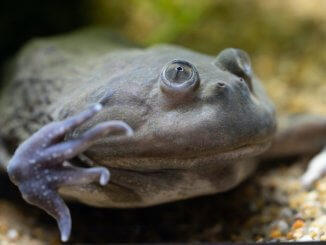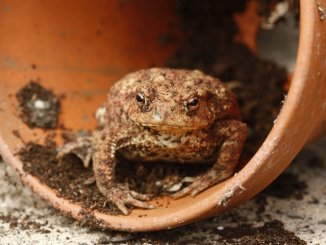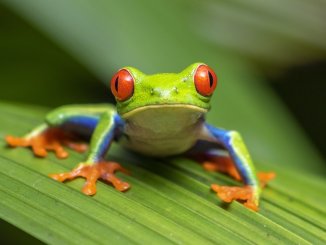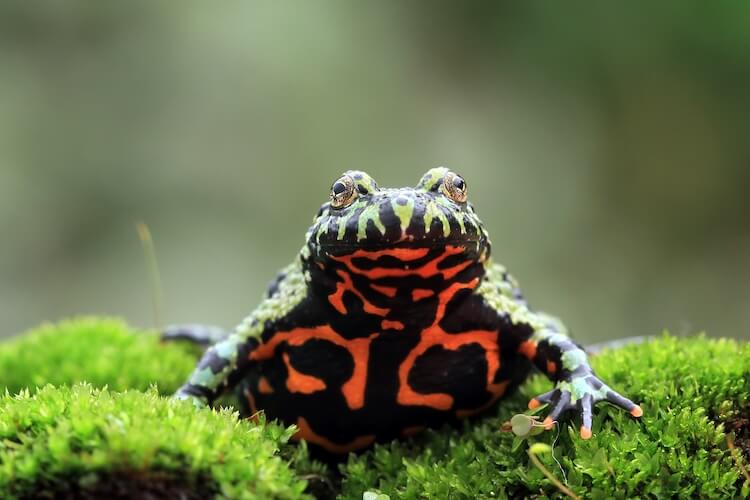
Are you looking for an active and beautiful exotic pet that loves water but is rarer than a fish? Look no further than a fire-bellied toad.
Interestingly despite being named a toad, this species is actually a type of frog.
These colorful amphibians are very popular because of their simple care needs, fiery patterns and ability to live in small groups. These factors combined make them an excellent beginner frog.
Despite their simple care, beginners should know they secrete toxins in their skin. This is a defense mechanism and can happen during handling if stressed. While not deadly, these toxins can cause skin irritation in sensitive people.
Keep reading to learn how to care for this species, the perfect tank setup, and our complete husbandry guide!
A Guide To Fire-Belly Toads
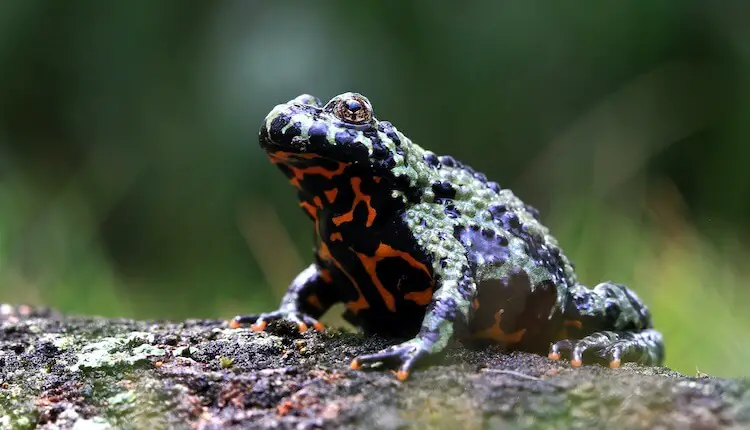
Fire Belly Toads (Bombina bombina) are small frogs from the Bombinatoridae family. This family also includes the bornean flat-headed frog (Barbourula genus) which are very rare and only kept by advanced keepers. Fire Belly species are named after toads because the warty bumps that cover their bodies are similar to those found on true toads. However, they are actually a type of frog.
They are exclusively an old world species. This means they are found in Europe or Asia and not America. There are six known species:
- European
- Yellow-bellied
- Yunnan
- Oriental
- Apennine yellow-bellied
- Hubei
The yellow-bellied and European fire-bellied species were discovered by Swedish zoologist Carl Linnaeus in the 1700s. The Yunnan and Oriental Fire species were named by Belgian zoologist George Albert Boulenger in the 19th century. The most recent discovery is the Hubei Fire-Bellied Toad that was found in China in 1960.
European fire-bellies are the most popular pet species. They make colorful and interesting pet amphibians. Their diurnal activity means are active during the day – unlike many pet frogs that are nocturnal.
Unfortunately due to the high demand for European individuals their populations are decreasing in several European countries.
Keeping fire belly toads is fairly simple and you will be rewarded with many years of interesting behaviors as they have a lifespan of 20 years. As pets their main health issue is fungal infections caused by stress or injury. Setting up their tank properly and keeping their tank clean will help to prevent infections.
Their tank setup is simple as they thrive in room temperatures without needing any extra heat. But, they do need a large swimming space. We recommend at least half of their tank should have deep dechlorinated water (more on this in the tank setup guide below).
Adults are small and normally grow to just two inches in size. Because of this they can be housed in small groups as long as each toad has enough space to stake out its own territory.
Except for overeating this frog is very resistant to diseases. A well fed toad will be round and slightly flat, while an overfed individual will be spherical and bloated.
Fire-bellied toads are opportunistic hunters. They will eat almost any small animal that moves. As pets they should eat a varied diet of crickets, fruit flies, bloodworms and earthworms.
Appearance
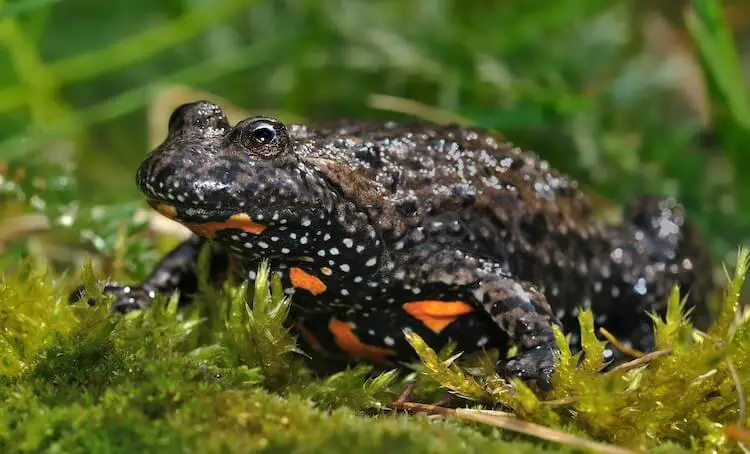
The Fire Belly Toad is a small amphibian with bumpy skin that is covered in small tubercles (i.e. small bumpy tissue). They have long legs with webbed toes and small eyes on top of their heads.
There are six known species of Fire Belly Toad, but only three are kept as pets. All of the species are similar in care, but they are different in appearance.
European fire (Bombina bombina)
This is the largest of all the Fire Belly Toads. They have a green or olive back with black spots and an orange and black belly. They are flat in appearance with muscular back legs and heart-shaped pupils.
European species are found in eastern and central Europe in countries like Germany, Denmark, Austria and Romania.
Oriental fire (Bombina orientalis)
These individuals have green backs with black patches or streaks. These frogs are a brighter green than the European or yellow-bellied. They also have a more vibrant red on their underside. They have yellow tips on their fingers and toes and triangular pupils.
Oriental fire-bellied individuals are exclusive to Russia, China, Japan, and Korea.
Yellow-bellied (Bombina variegata)
This toad is one of the smallest in its family. Unlike the European, they rarely have green markings and are instead gray-brown with a bright yellow belly. They are slightly rounder than other species. Depending on where they are found some individuals have no black markings on their belly and others are completely black.
Size
The European Fire Belly is the biggest species and grows to a size of 2.4 inches. The Oriental variety has a maximum length of 2 inches. Yellow Bellies are the smallest and grow between 1.5 to 2 inches. Newly metamorphosed froglets will be half an inch long.
Unlike other popular pet species such as the Pacman frog, they are classified as small.
Females are slightly larger and rounder than males, but it can be difficult to sex a single individual. It is easier to use a group of toads as a comparison. This will make it clear which are males and which are females.
Can You Handle Fire Belly Toads?
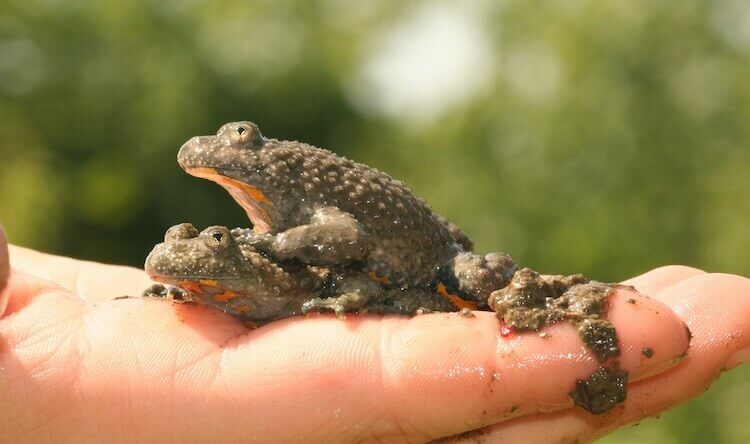
Fire Belly Toads have a very docile personality but they should not be handled. This species secretes skin toxins that can cause mild to moderate irritation to your skin, eyes and mouth. For this reason young children should not hold fire-bellied toads.
Fire-Belly Toads also have very sensitive skin. Their skin can absorb trace amounts of lotion or sunscreen which is harmful to them. So, if an adult needs to hold them they should wash their hands before and after.
Luckily these frogs are highly active so you do not need to take them out of their enclosure to be entertained. You will see them moving about during the day and often go in and out of the water. If your enclosure includes plants you may find your toad on the lower leaves.
In the wild Fire Belly Toads live near pools in streams, swamps, wetlands and man-made ponds. They are typically found in groups, but are not cooperative and can be aggressive to each other if they get too close.
As pets they can live by themselves or in small groups of four or five. They are not overly aggressive but may bite each other during an enthusiastic feeding session. You can stop this by using a large terrarium and separate feeding dishes.
Over the winter these frogs will hibernate. This starts in early October and ends in mid-May when they come out to breed.
During the breeding season, males develop dark nuptial pads on their thumbs and will call for females. Males declare their territory by kicking or vibrating in the water. This is one of the reasons they have muscular back legs and it signals other males to stay away.
How Poisonous Is A Fire Belly Toad?
When threatened or stressed Fire Belly Toads have a unique form of defense known as the unkenreflex. A frightened frog will flip onto its back and inflate its body. This shows off the bright warning coloration on its legs and belly. At the same time it will secrete toxins from skin glands. These toxins can cause moderate skin irritation. If left alone for a few minutes they will flip back over and resume normal activities.
How Often Should You Feed A Fire Belly Toad?
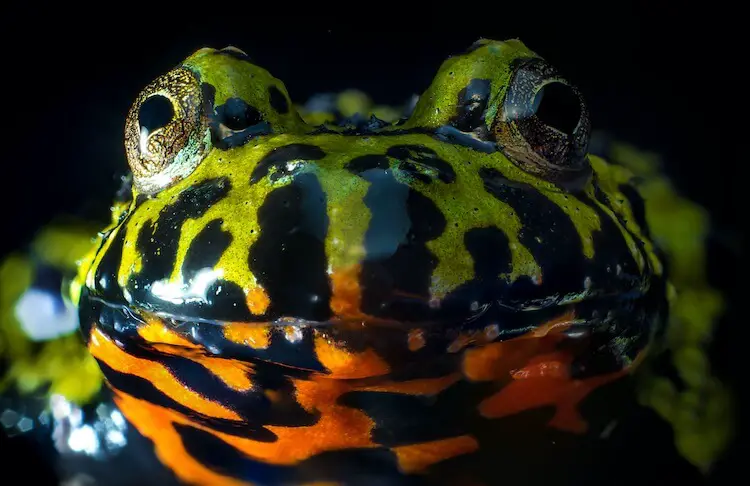
Fire Belly Toads should be fed two to five prey items three times a week. Prey should not be larger than the width of your frog’s mouth. You should chop earthworms and bloodworms into smaller pieces. You can feed them:
- Bloodworms
- Crickets
- Earthworms
- Flightless Fruit Flies
- Springtails
Many of these prey species can be bought in bulk at pet stores and are easy to grow in captivity. Never use wild-caught insects as they can transmit diseases.
To keep insects from escaping into the enclosure, place them in a small escape-proof dish. Then place this dish in the terrarium. Frogs quickly learn to associate a dish with food.
Fire-Belly Toads are opportunistic carnivores. In the wild, they normally prey on mosquito larvae, aquatic insects, worms, beetles, spiders, and tadpole eggs. But, they will eat as much of whatever food they can find. Unlike Pixie Frogs, they are not ambush predators and will, instead, chase prey.
Monitor the size of your toad as he grows. They will overeat if given the chance. They should be fed on a schedule and not allowed to eat freely.
Every other week dust feeder insects with a vitamin D3 supplement powder to increase their calcium content. You can also gut load their insects with vegetables high in beta-carotene (e.g. carrots). This will help to enhance your frog’s natural colors.
How Long Does A Fire Belly Toad Live?
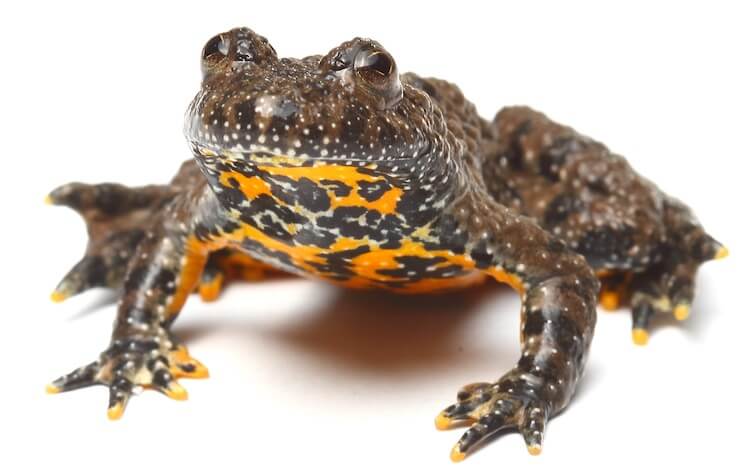
Fire Belly Toads have a maximum lifespan of 20 years. It is more common for them to live between 10 to 15 years. They are hardy amphibians that do not suffer from many health problems. Fungal infections and nutrient deficiencies are the only health issues you will need to watch for.
Fungal infections can be caused by stress, extreme temperatures, high humidity and poor husbandry.
These infections often show up as white or red patches or streaks on the skin. If you notice any frogs with unusual skin lesions, then immediately isolate it and take it to an exotic animal vet. You should be using a hygrometer and thermometer to ensure the humidity and tank temperature is within an acceptable range.
Nutrient deficiencies are caused by feeding your Fire Belly Toad a single type of prey. Sometimes it can be caused by inefficiently gut-loading prey too. Nutrient deficient toads are weaker, less vibrant and may lose limb strength.
It is important you feed a mixture of hard (e.g. crickets) and soft prey (e.g. bloodworms) to your frog. This will help to provide a healthier diet with more nutrients.
Fire-Bellied Toad Tank
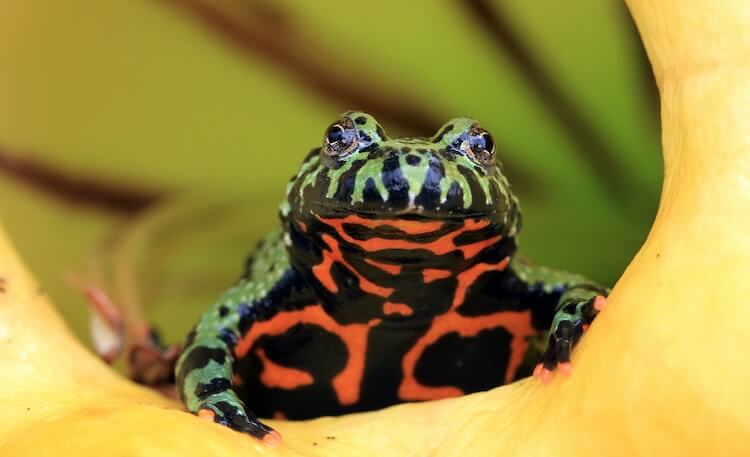
These frogs are small, but their active nature means they need a big tank. A single frog can live comfortably in a 10-gallon tank. Groups of four or five should live in a 40-gallon enclosure as each frog needs about 10 gallons of space.
All three pet species like to live around shallow, grassy marshes and temporary stagnant pools.
Their enclosure should have a land part (i.e. terrestrial habitat) as well as an aquatic part to swim in. This is known as a paludarium.
Fill half of the paludarium with three inches of dechlorinated water. You can then build up a ramp area with rocks and gravel to allow the frogs easy access to both areas. You will need to spot-clean any feces daily and do a full water change every week.
The land portion of the terrarium can be made of organic fertilizer-free potting soil. Some owners choose not to use substrate as it makes cleaning easier. But, using soil means you can also add moss and live plants. This more closely mimics their natural habitat and provides hiding spaces too. This is especially important if you choose to have more than one toad in the tank.
If you notice your frogs becoming aggressive towards each other then add more décor to block their line of sight. If this does not work then purchase a larger enclosure. Usually more space and hides will resolve any territorial issues.
Unlike tropical frogs such as the tomato frog, Fire Belly Toads prefer temperatures of 70 to 75°F during the day. At night this can be as low as 60 to 65°F. These temperatures are within the range of most normal rooms. You should not need to use an external heater unless your indoor temperatures drop below 55°F.
These frogs need a moderate humidity of 50 to 70% which should be maintained naturally by the water in the tank.
As well as not needing any extra heating devices, Fire Belly Toads do not need any special lighting. Putting their tank in a room with a window will give them a good day/night cycle. If they do not have access to natural light then use a 5.0 UVB bulb on an automatic 12 hour timer.
What Do You Need For A Fire Belly Toad?
A 10-gallon glass tank setup is perfect for one individual. This will cost less than $50 and is a great tank to start with. You do not need to add any heating or lighting provided the room the tank is in stays between 70 to 75°F during the day and has a window.
- Tank Type: glass.
- Tank Size: 10-gallon tank.
- Lighting: only natural.
- Substrate: three inches of potting soil.
Summary
| Common Name (s) | Fire Belly Toad, Fire Frog |
|---|---|
| Scientific Name | Bombina Bombina, Bombina Orientalis, Bombina Variega/td> |
| Family Name | Bombinatoridae |
| Genus Name | Bombina |
| Range | Central Europe to southern Russia and East Asia |
| Adult Size | 1.5 to 2.4 inches |
| Lifespan | 10 to 20 years |
| Similar Species/Popular Alternatives | Poison Dart Frog, White’s Tree Frog, Gray Tree Frog, American Toad |
Fire Belly Toads make one of the best pets for owners of all skill levels. Whether you are an experienced keeper or new to the hobby, they are a colorful addition to any collection.
They are a great choice for someone who wants their first pet frog. However, they are not great for children because of their small bodies and skin-irritating toxin secretions. When handled they can secrete a toxic substance from their skin. It can cause pain and redness if rubbed into the skin or eyes.
These little toads are one of the easiest to care for. They thrive in room temperatures and do not need any special lighting or heating. They are also resistant to most diseases and can live for 20 years.
Thinking of purchasing a Fire-Bellied Toad or already have one you love? Let us know in the comments!

